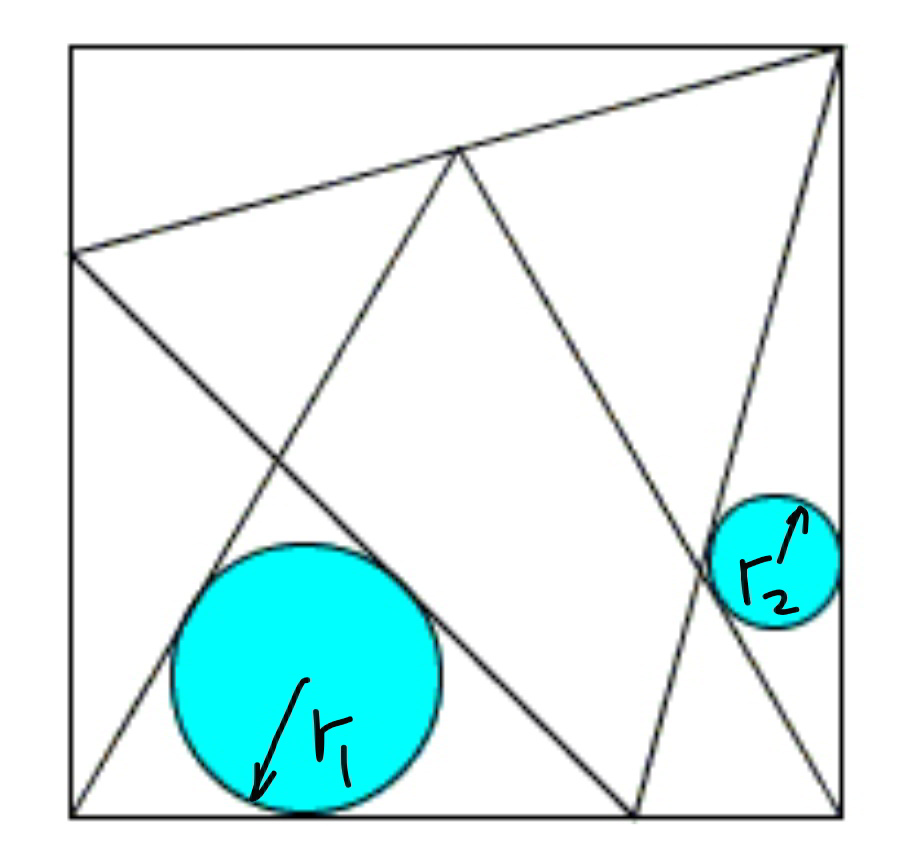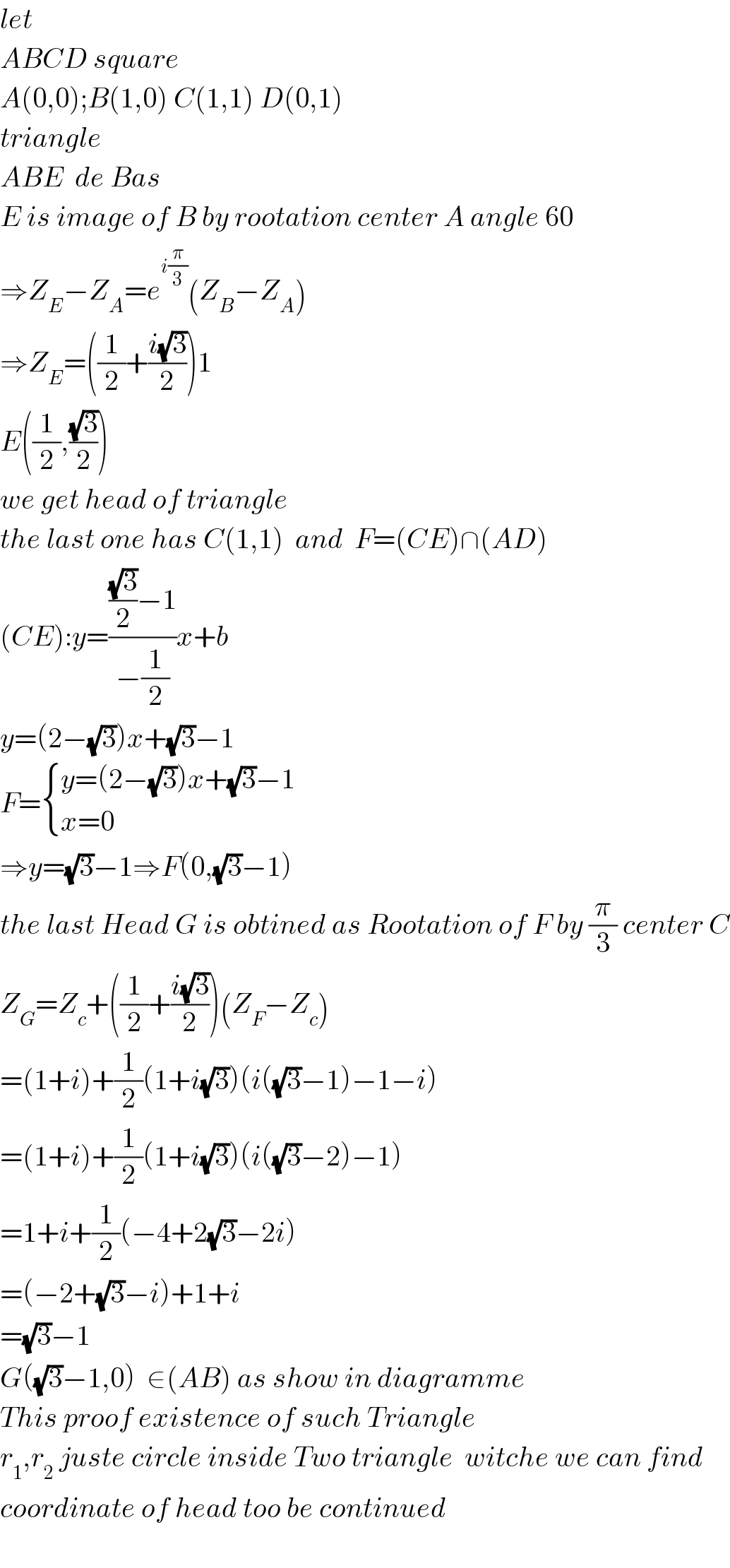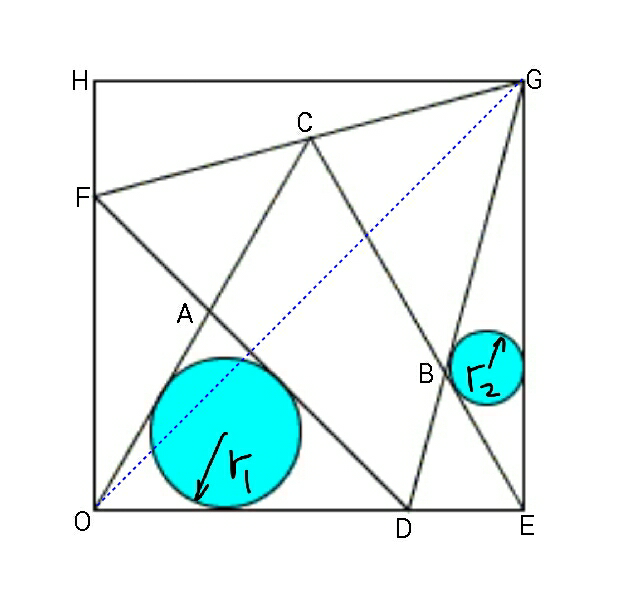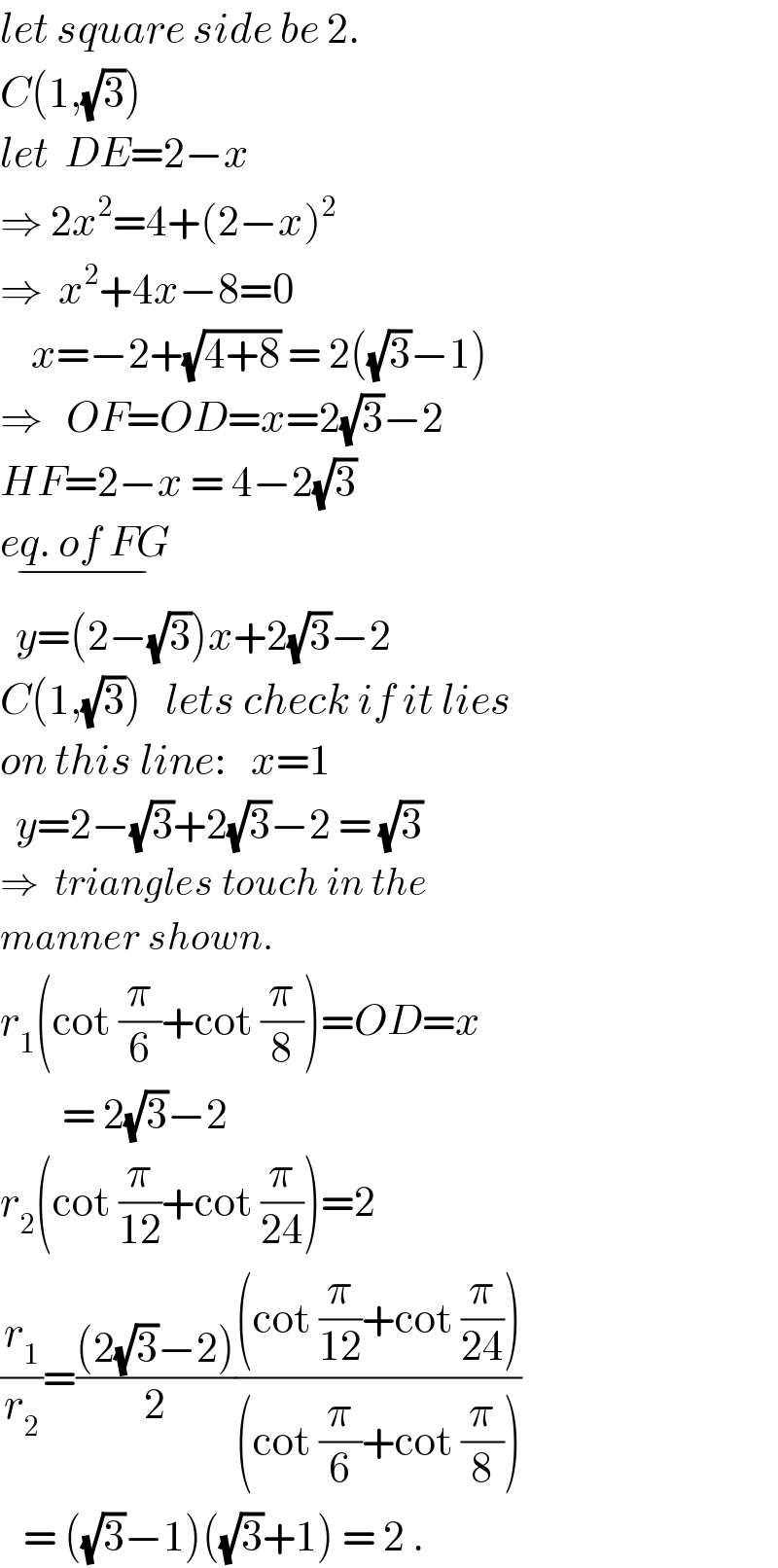Question Number 80015 by mr W last updated on 30/Jan/20

Commented by mr W last updated on 30/Jan/20

$$\mathrm{1}.\:{Prove}\:{that}\:{both}\:{equilaterial}\:{triangles} \\ $$$${touch}\:{each}\:{other}\:{in}\:{the}\:{square}\:{as}\:{shown}. \\ $$$$\mathrm{2}.\:{Find}\:{r}_{\mathrm{1}} /{r}_{\mathrm{2}} \\ $$
Commented by jagoll last updated on 30/Jan/20

$${circle}\:{againt} \\ $$
Answered by mind is power last updated on 30/Jan/20

$${let}\: \\ $$$${ABCD}\:{square} \\ $$$${A}\left(\mathrm{0},\mathrm{0}\right);{B}\left(\mathrm{1},\mathrm{0}\right)\:{C}\left(\mathrm{1},\mathrm{1}\right)\:{D}\left(\mathrm{0},\mathrm{1}\right) \\ $$$${triangle}\: \\ $$$${ABE}\:\:{de}\:{Bas} \\ $$$${E}\:{is}\:{image}\:{of}\:{B}\:{by}\:{rootation}\:{center}\:{A}\:{angle}\:\mathrm{60} \\ $$$$\Rightarrow{Z}_{{E}} −{Z}_{{A}} ={e}^{{i}\frac{\pi}{\mathrm{3}}} \left({Z}_{{B}} −{Z}_{{A}} \right) \\ $$$$\Rightarrow{Z}_{{E}} =\left(\frac{\mathrm{1}}{\mathrm{2}}+\frac{{i}\sqrt{\mathrm{3}}}{\mathrm{2}}\right)\mathrm{1} \\ $$$${E}\left(\frac{\mathrm{1}}{\mathrm{2}},\frac{\sqrt{\mathrm{3}}}{\mathrm{2}}\right) \\ $$$${we}\:{get}\:{head}\:{of}\:{triangle} \\ $$$${the}\:{last}\:{one}\:{has}\:{C}\left(\mathrm{1},\mathrm{1}\right)\:\:{and}\:\:{F}=\left({CE}\right)\cap\left({AD}\right) \\ $$$$\left({CE}\right):{y}=\frac{\frac{\sqrt{\mathrm{3}}}{\mathrm{2}}−\mathrm{1}}{−\frac{\mathrm{1}}{\mathrm{2}}}{x}+{b} \\ $$$${y}=\left(\mathrm{2}−\sqrt{\mathrm{3}}\right){x}+\sqrt{\mathrm{3}}−\mathrm{1} \\ $$$${F}=\begin{cases}{{y}=\left(\mathrm{2}−\sqrt{\mathrm{3}}\right){x}+\sqrt{\mathrm{3}}−\mathrm{1}}\\{{x}=\mathrm{0}}\end{cases} \\ $$$$\Rightarrow{y}=\sqrt{\mathrm{3}}−\mathrm{1}\Rightarrow{F}\left(\mathrm{0},\sqrt{\mathrm{3}}−\mathrm{1}\right) \\ $$$${the}\:{last}\:{Head}\:{G}\:{is}\:{obtined}\:{as}\:{Rootation}\:{of}\:{F}\:{by}\:\frac{\pi}{\mathrm{3}}\:{center}\:{C} \\ $$$${Z}_{{G}} ={Z}_{{c}} +\left(\frac{\mathrm{1}}{\mathrm{2}}+\frac{{i}\sqrt{\mathrm{3}}}{\mathrm{2}}\right)\left({Z}_{{F}} −{Z}_{{c}} \right) \\ $$$$=\left(\mathrm{1}+{i}\right)+\frac{\mathrm{1}}{\mathrm{2}}\left(\mathrm{1}+{i}\sqrt{\mathrm{3}}\right)\left({i}\left(\sqrt{\mathrm{3}}−\mathrm{1}\right)−\mathrm{1}−{i}\right) \\ $$$$=\left(\mathrm{1}+{i}\right)+\frac{\mathrm{1}}{\mathrm{2}}\left(\mathrm{1}+{i}\sqrt{\mathrm{3}}\right)\left({i}\left(\sqrt{\mathrm{3}}−\mathrm{2}\right)−\mathrm{1}\right) \\ $$$$=\mathrm{1}+{i}+\frac{\mathrm{1}}{\mathrm{2}}\left(−\mathrm{4}+\mathrm{2}\sqrt{\mathrm{3}}−\mathrm{2}{i}\right) \\ $$$$=\left(−\mathrm{2}+\sqrt{\mathrm{3}}−{i}\right)+\mathrm{1}+{i} \\ $$$$=\sqrt{\mathrm{3}}−\mathrm{1} \\ $$$${G}\left(\sqrt{\mathrm{3}}−\mathrm{1},\mathrm{0}\right)\:\:\in\left({AB}\right)\:{as}\:{show}\:{in}\:{diagramme} \\ $$$${This}\:{proof}\:{existence}\:{of}\:{such}\:{Triangle} \\ $$$${r}_{\mathrm{1}} ,{r}_{\mathrm{2}} \:{juste}\:{circle}\:{inside}\:{Two}\:{triangle}\:\:{witche}\:{we}\:{can}\:{find} \\ $$$${coordinate}\:{of}\:{head}\:{too}\:{be}\:{continued} \\ $$$$ \\ $$
Answered by ajfour last updated on 30/Jan/20

Commented by ajfour last updated on 30/Jan/20

$${let}\:{square}\:{side}\:{be}\:\mathrm{2}. \\ $$$${C}\left(\mathrm{1},\sqrt{\mathrm{3}}\right) \\ $$$${let}\:\:{DE}=\mathrm{2}−{x} \\ $$$$\Rightarrow\:\mathrm{2}{x}^{\mathrm{2}} =\mathrm{4}+\left(\mathrm{2}−{x}\right)^{\mathrm{2}} \\ $$$$\Rightarrow\:\:{x}^{\mathrm{2}} +\mathrm{4}{x}−\mathrm{8}=\mathrm{0} \\ $$$$\:\:\:\:{x}=−\mathrm{2}+\sqrt{\mathrm{4}+\mathrm{8}}\:=\:\mathrm{2}\left(\sqrt{\mathrm{3}}−\mathrm{1}\right) \\ $$$$\Rightarrow\:\:\:{OF}={OD}={x}=\mathrm{2}\sqrt{\mathrm{3}}−\mathrm{2} \\ $$$${HF}=\mathrm{2}−{x}\:=\:\mathrm{4}−\mathrm{2}\sqrt{\mathrm{3}} \\ $$$$\underset{−} {{eq}.\:{of}\:{FG}} \\ $$$$\:\:{y}=\left(\mathrm{2}−\sqrt{\mathrm{3}}\right){x}+\mathrm{2}\sqrt{\mathrm{3}}−\mathrm{2} \\ $$$${C}\left(\mathrm{1},\sqrt{\mathrm{3}}\right)\:\:\:{lets}\:{check}\:{if}\:{it}\:{lies} \\ $$$${on}\:{this}\:{line}:\:\:\:{x}=\mathrm{1} \\ $$$$\:\:{y}=\mathrm{2}−\sqrt{\mathrm{3}}+\mathrm{2}\sqrt{\mathrm{3}}−\mathrm{2}\:=\:\sqrt{\mathrm{3}} \\ $$$$\Rightarrow\:\:{triangles}\:{touch}\:{in}\:{the} \\ $$$${manner}\:{shown}. \\ $$$${r}_{\mathrm{1}} \left(\mathrm{cot}\:\frac{\pi}{\mathrm{6}}+\mathrm{cot}\:\frac{\pi}{\mathrm{8}}\right)={OD}={x} \\ $$$$\:\:\:\:\:\:\:\:=\:\mathrm{2}\sqrt{\mathrm{3}}−\mathrm{2} \\ $$$${r}_{\mathrm{2}} \left(\mathrm{cot}\:\frac{\pi}{\mathrm{12}}+\mathrm{cot}\:\frac{\pi}{\mathrm{24}}\right)=\mathrm{2} \\ $$$$\frac{{r}_{\mathrm{1}} }{{r}_{\mathrm{2}} }=\frac{\left(\mathrm{2}\sqrt{\mathrm{3}}−\mathrm{2}\right)}{\mathrm{2}}\frac{\left(\mathrm{cot}\:\frac{\pi}{\mathrm{12}}+\mathrm{cot}\:\frac{\pi}{\mathrm{24}}\right)}{\left(\mathrm{cot}\:\frac{\pi}{\mathrm{6}}+\mathrm{cot}\:\frac{\pi}{\mathrm{8}}\right)} \\ $$$$\:\:\:=\:\left(\sqrt{\mathrm{3}}−\mathrm{1}\right)\left(\sqrt{\mathrm{3}}+\mathrm{1}\right)\:=\:\mathrm{2}\:. \\ $$
Commented by mr W last updated on 30/Jan/20

$${thank}\:{you}\:{sir}!\:{perfectly}\:{solved}! \\ $$
